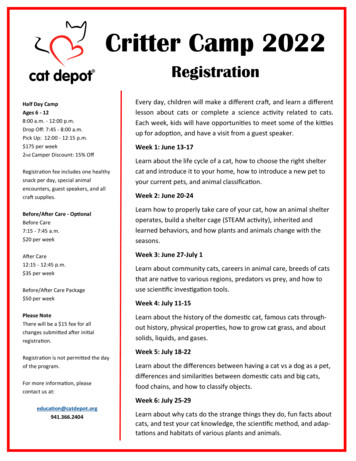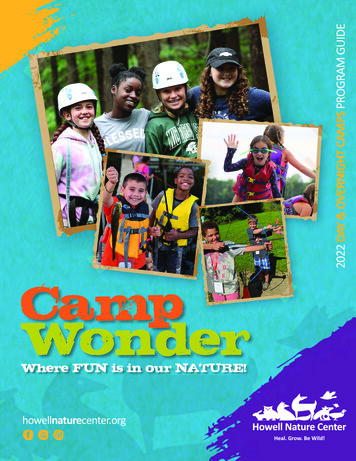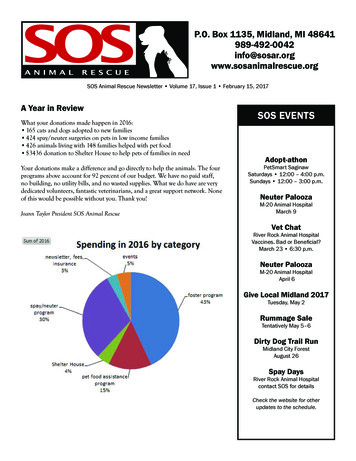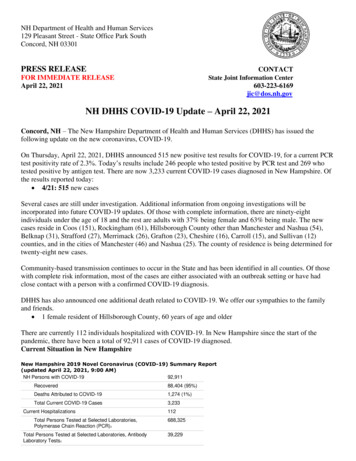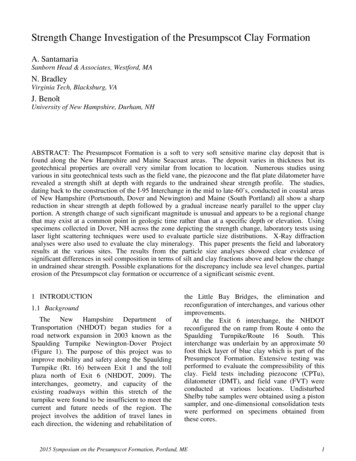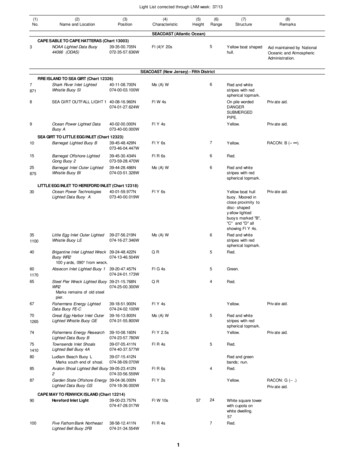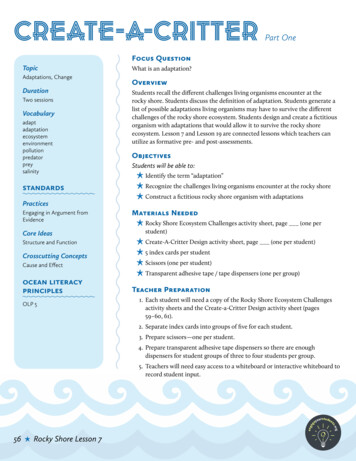
Transcription
Create-a-CritterPart OneFocus QuestionTopicAdaptations, ChangeDurationTwo entpollutionpredatorpreysalinityStandardSWhat is an adaptation?OverviewStudents recall the different challenges living organisms encounter at therocky shore. Students discuss the definition of adaptation. Students generate alist of possible adaptations living organisms may have to survive the differentchallenges of the rocky shore ecosystem. Students design and create a fictitiousorganism with adaptations that would allow it to survive the rocky shoreecosystem. Lesson 7 and Lesson 19 are connected lessons which teachers canutilize as formative pre- and post-assessments.ObjectivesStudents will be able to:Identify the term “adaptation”Recognize the challenges living organisms encounter at the rocky shoreConstruct a fictitious rocky shore organism with adaptationsPracticesEngaging in Argument fromEvidenceMaterials NeededCore IdeasRocky Shore Ecosystem Challenges activity sheet, page (one perstudent)Structure and FunctionCreate-A-Critter Design activity sheet, page (one per student)Crosscutting ConceptsCause and Effect5 index cards per studentScissors (one per student)Transparent adhesive tape / tape dispensers (one per group)Ocean LiteracyPrinciPLeSOLP 5Teacher Preparation1. Each student will need a copy of the Rocky Shore Ecosystem Challengesactivity sheets and the Create-a-Critter Design activity sheet (pages59–60, 61).2. Separate index cards into groups of five for each student.3. Prepare scissors—one per student.4. Prepare transparent adhesive tape dispensers so there are enoughdispensers for student groups of three to four students per group.engagRocky Shore Lesson 7our s tuden.or56eytsg5. Teachers will need easy access to a whiteboard or interactive whiteboard torecord student input.
Create-a-Critter, Part One continued . . .BackgroundTeacher TipsHave students share their“critters” by doing a classwalk—have studentsleave their critters anddesign sheets on theirdesks and visit eachother’s creations.Borrow tape dispensersfrom other teachers forthis one class session tosave time and money.An adaptation is a body part or a behavior that helps a living thing survive inits environment. Rocky shore organisms need adaptations to survive the harshand constantly changing environment of their rocky shore ecosystem. Thesechallenges include some of the following: the waves, the tides, the temperatures,finding food, and evading predators. Other challenges to rocky shore organismsinclude the flux of salinity levels of the saltwater, various ranges of light, as wellas human factors such as pollution and carelessness when visiting the rockyshore.Some adaptations of rocky shore organisms include: thick shells, round shells,impermeable shells, the ability to retain water, holdfasts, secreted substancesthat allow organisms to attach well to rocks, spiny bodies, regeneration,exoskeletons, gathering in groups, camouflage, filter feeding, seeking crevices forshelter, burrowing abilities, ability to lower metabolic rates, and many more!ProcedurePart One1. Ask students what humans do differently to adapt to winter weather. Havestudents share their answers.Extension SuggestionsHave students createa zoo plaque for thecritter they created.Have students includethe name of the critter, aLatin name, habitat, size,appearance, diet, threats,etc. Show studentsphotos of plaques ofanimals found at zoos.Students could alsoinclude drawings of theircritters as well as a mapof the world indicatingwhere their critters canbe found.2. Inform students that to adapt means to change something about yourappearance, behavior or surroundings in order to make living and survivingeasier.3. Have students refer back to the inferences they have made over the past fewlessons of how rocky shore organisms can survive their constantly changingecosystem.4. Inform students that rocky shore organisms all have something calledadaptations—body parts or behaviors that help a living thing survive in itsenvironment.5. Have students get into groups of three or four to fill out the Rocky ShoreEcosystem Challenges activity sheet (page 60).6. When students complete their lists, have them share their inferences andrecord them somewhere for all students to see. Save this list to share withthe class for a future lesson! Students may bring their own sheets home, orpaste them into their science notebooks (if applicable).Part Two7. Inform students that they are going to be creating a fictitious rocky shoreorganism that can survive the challenges of the rocky shore.engagRocky Shore Lesson 7our s tuden.or57eytsg8. Inform students that they will be creating their “critter” with only five indexcards, scissors and tape.
Create-a-Critter, Part One continued . . .Procedure (continued)9. Review the Create-a-Critter Design activity sheet (page 61) withstudents.BooksCrabby and Nabby: ATale of Two Blue Crabs bySuzanne TateSpiny Sea Star: A Tale ofSeeing Stars by SuzanneTate10. Have students get back into their previous groups if they are not in themalready so that they can share transparent adhesive tape/tape dispensers.11. Have students create their rocky shore organisms and complete the Createa-Critter Design activity sheets.12. If there’s time, have students share their critters and their critters’adaptations with either their groups or the entire class.13. Collect the Create-a-Critter Design activity sheets and the students’ crittersfor a future lesson. If desired, you can display their critters.Wrap-upWebsitesCheck out the CrashCourse Kids YouTubeChannel episode titledLiving Things Changewhich answers thequestion, “What canhappen to living thingswhen the world aroundthem changes?”Watch a BrainPOP videoon ecosystems and takethe quiz! (Subscriptionrequired.)Ask students to identify the main challenges rocky shore organismsencounter regularly.Ask students to define “adaptation.”Remind students that adaptations are the body parts or behaviors thatrocky shore organisms use to live or survive easier in their constantlychanging ecosystem.Scientist NotebookengagRocky Shore Lesson 7our s tuden.or58eytsgStudents can record thedefinition of adaptation,ecosystem andenvironment. Studentscan paste the Rocky ShoreEcosystem Challengesactivity sheet into theirnotebook.
Rocky Shore EcosystemChallengesName:Date:The chart on the next page lists five of the main challenges rocky shore organismsencounter in their effort to survive. Rocky shore organisms have adaptations thatenable them to survive these challenges.With your group, come up with a list of adaptations you think rocky shoreorganisms may have to survive their rocky shore ecosystem.Tip for Students: Take turns sharing your ideas by choosing one person to startthe list with one idea. Continue to share ideas by having each student share oneidea, taking turns in a clockwise direction.!ChallengesWavesWaves are constantly beating against the rockyshore. Sometimes the waves are small and gentle andsometimes the waves are large and strong. This meanswaves can be crashing into organisms above land, orcausing the water to move around organisms livingunder the water.Finding FoodFood can be difficult for organisms to find or eat becausedifferent types of prey have adaptations that help themhide well or allow them to defend themselves well. It canalso be difficult to find food because the constant changing of the environment can move organisms away fromfood sources (or food sources away from organisms).TidesTides cause the level of the ocean to rise and fall twicea day. This means that some organisms spend partof the day living above the water and part of the dayliving under the water.Avoiding PredatorsPredators can be difficult to avoid because they have adaptations that help them hunt well. It can also be difficultto avoid predators because the constant changing of theenvironment can expose organisms to predators.engagRocky Shore Lesson 7our s tuden.or59eytsgChanging TemperaturesThe temperature of the rocky shore’s ocean water,rocks and sand, and air can change a lot during theday and throughout the year. This means organismsneed to be able to survive both warm and dryconditions, and cold and wet conditions.
Rocky Shore voidingPredatorsFinding 5.5.engagRocky Shore Lesson 7our s tuden.or60eytsgAdaptationsWavesName:
Create-A-Critter DesignName:Date:Draw a sketch of your critter here.Your critter’s species:(for example: snail, crab, fish)Your critter’s name:Your critter’s adaptations:1.4.2.5.3.engagRocky Shore Lesson 7our s tuden.or61eytsgHow do your critter’s adaptations help it survive?
a-Critter Design activity sheets. 12. If there's time, have students share their critters and their critters' adaptations with either their groups or the entire class. 13. Collect the Create-a-Critter Design activity sheets and the students' critters for a future lesson. If desired, you can display their critters. Wrap-up

